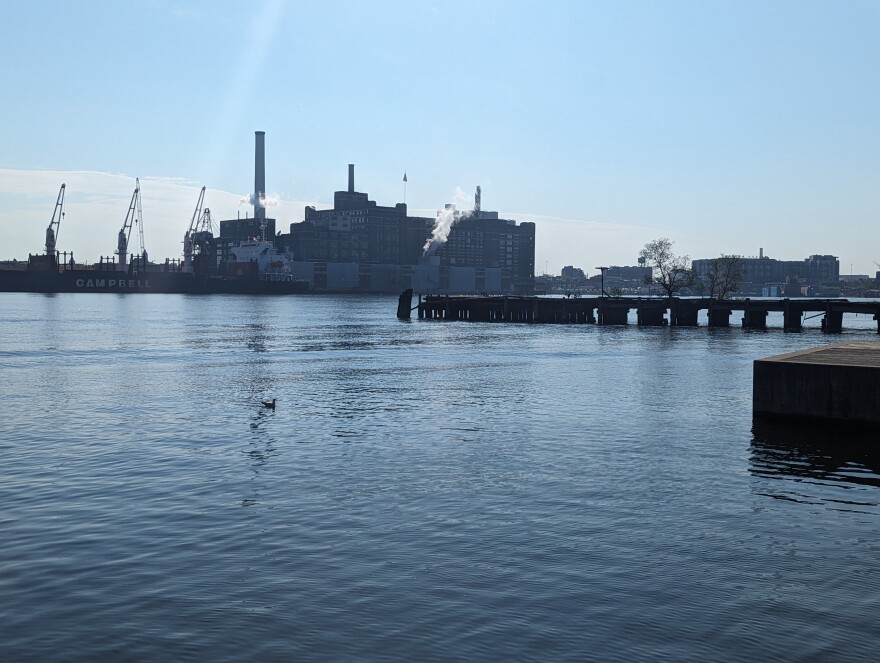If you had the chance to swim in the Inner Harbor, would you take it?
Well, now you have your chance. On June 23rd, 125 lucky (or brave) people ages 18 and up will have the opportunity to jump off the Bond Street Wharf for a swim. Registration opens May 29th for those who subscribe to the “Harbor Splash” newsletter.
The Harbor Splash event is part of Waterfront Partnership’s Healthy Harbor Initiative which has the goal to make a “swimmable, fishable” Baltimore Harbor.
It’s the first time there’s been a sanctioned swimming event in the harbor since the 1980s, said Adam Lindquist, the vice president of Waterfront Partnership.
What to expect on the day
Advance registration is required and will be offered to Harbor Splash newsletter recipients. The sign-up opens on May 29th at noon. Organizers expect spaces to fill up almost immediately. Interested people can join that list here.
Mayor Brandon Scott and Comptroller Brooke Lierman plan to take the plunge too that morning as part of a ceremonial splash.
Groups will be staggered and all participants will wear personal flotation devices (PFDs).
“For this first one, we are in a confined area in Fells Point. So people will be able to jump in, splash around, have fun for, you know, 5-10 minutes, and then hop out and we'll bring up the next group to jump in,” Lindquist explained. “We're doing it in a very controlled, very safe environment, especially because it's just the first time anyone has tried this in recent memory.”
The nonprofit acknowledges that many people will be skeptical about the water’s safety but in a news release the organization said that through routine monitoring it has found that “water in the Harbor meets Maryland’s standard for swimming on dry weather days.” That refers to a 48 hour timespan free of rainfall, which can cause sewer overflow and sweep animal waste off city streets and into the water.
For those reasons, Waterfront Partnership recommends that swimming can only take place during scheduled events.
“This is just the beginning. We want to see other events in the Harbor like triathlons, marathon swimming and stand-up paddleboard races. One day we may even have a beach,” said Lindquist.
Lindquist said that water-quality monitoring will happen everyday leading up to Harbor Splash to make sure the water meets swimmable beaches standards set by the Maryland Department of the Environment.
Water quality and bacteria concerns
“Swimming? Not for me,” said Alice Volpitta, the waterkeeper for environmental nonprofit Bluewater Baltimore when asked about swimming in the Inner Harbor.
According to bi-weekly water quality reports posted by Bluewater Baltimore, the most recent samples show locations around the Inner Harbor, including nearest the Bond Street Wharf, have higher levels of enterococcus (fecal) bacteria than the state deems safe for swimming. Their site reports that bacteria can be caused by sewage overflows, broken sewer pipes and animal waste.
The state creates those guidelines for swimming based on Environmental Protection Agency recommendations that calculate the risk of getting sick with gastroenteritis or another viral disease when coming into contact with a certain level of the bacteria, explained Volpitta.
“It's not as though if you go into the water at the failing threshold, you are definitely going to get sick. Just like if you go swimming in the ‘safe zone’ you may not be 100% safe — but you are relatively assured that you won't contract an illness based on the EPA guidelines,” said Volpitta.
Lindquist feels confident about the regular monitoring that Waterfront Partnership conducts — done five days a week during the recreational season — as opposed to the bi-weekly measurements done by Bluewater Baltimore.
“We are using the same standard used by the Maryland Department of the Environment at public swimming beaches, with the exception that we are doing it every single day,” said Lindquist.
Volpitta isn’t entirely certain about that logic. She says more research needs to be done and wonders about an apples-to-apples comparison between a traditional swimming beach and highly-industrial locations like Baltimore.
“Enterococcus bacteria is an indicator of the presence of other things in the water that will make you sick, so the pathogens that will actually cause illness…it's that this level of Enterococcus bacteria means that there could be Cryptosporidium or these other things that will make you sick,” she explained. “But in a situation where we have high levels of human sewage contamination, could it be possible that a lower bacterial level is still indicative of a high amount of pathogen that could potentially make you sick?”
Volpitta encourages anyone thinking about swimming or doing other activities around the Harbor to look at the city’s sewage overflow map and the most recent reports on the wastewater consent decree.
Those can be found below.
Sewage overflow map: https://publicworks.baltimorecity.gov/interactive-maps
Wastewater consent decree reports: https://publicworks.baltimorecity.gov/wastewater-treatment-consent-decree-program-0
Harbor Splash sign-ups: https://www.waterfrontpartnership.org/harborsplash







